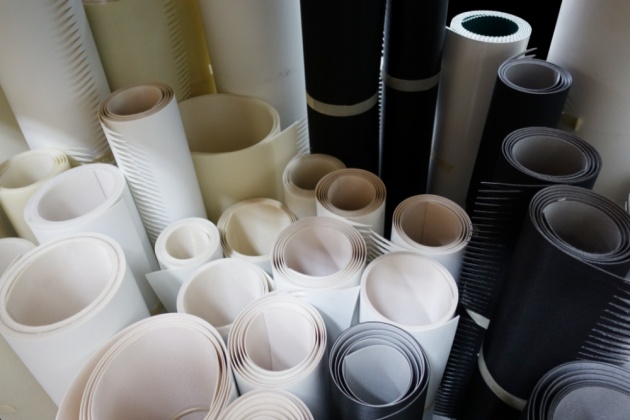
Thinking about making an investment in a conveyor belt system for your assembly line? Choosing a conveyor that best fits your firm's needs is crucial. If you really want to make an intelligent purchase, you might want to understand the fundamental types of conveyor belts and match them with implementations for your business. The right belt could even help to boost the gross margin, streamline the assembly line, and contribute to the development of the business in ways you may not first imagine. In fixture and exceptional machine construction, small conveyor belts can be used where they are used to feed in and feed smaller parts. To get going, here is a description of the 8 basic types of conveyor belts and their implementations.
The Types:
- Roller Bed Conveyors:
On the surface of a conveyor belt of this sort, rollers that are chosen to comply with the requirements of manufacturing exist. The roller's size is proportionate to the body mass or required velocity of the goods that will move along the belt. Shorter conveyor belts falling beneath this type can consist of only two rollers. And, as the distance between both the belt's two edges rises, the belt may need more for it to work. A roller bed installation is appropriate when items are gravitationally packed onto the belt. This is because mechanical shock and disruption to the rollers will result from manually loading. This type of conveyor is also a good choice to move items over vast distances as they prevent corrosion, making shifting along the belt smoother for products. These conveyor belts can be used to stack, sort, assemble, examine and transport products. Common applications for roller bed conveyor belts usually involve postal sorting and baggage handling mechanisms at the airport. - Flat Belt Conveyors:
One of the most popular conveyor systems being used today is the flat belt conveyor belt. Flat belts are beneficial for inner conveyance, i.e. conveying items within an installation. This form of conveyor belt uses a combination of powered pulleys to relocate a constant flat belt which may consist of either porous material or synthetic fabric (e.g. polyester, nylon). Products are placed at the top of the belt and transported from one end to the next. As its belts can be constructed from different types of materials, this form of the conveyor belt is incredibly flexible. Flat belt systems are often the ideal conveyor for commercial conditions, washing down fields and long assembly lines. It can also evoke small, soft, or infrequently shaped products, mounted with the right belt, without affecting them. - Modular Belt Conveyors:
While a single continuous loop of material is used by flat belt conveyors, composite conveyor belt structures use a single loop consisting of myriad interconnected sections, generally made of hard plastic. Often, they are easier to wash, and much more resistant to rough and confrontational fabrics. It allows for easier maintenance and repair of rigid belt conveyors than their flat belt counterparts. Modular belt conveyors are ideally suited for applications requiring corner journeys. In fact, with a single belt and the same motor, they can travel straight, go around a corner, and incline and decline all through. Other types of conveyor belts can also achieve this feat functionally, but only with a lot of customization options and additional expenses. Modular plastic belts also provide for complex conveyor models without sacrificing belt monitoring. - Cleated Belt Conveyors:
Cleated belt conveyors highlight the layouts with vertical cleats or barriers. During inclines and decreases, these cleats can keep loose components secure to ensure consistent spacing between products, and more. Additionally, cleats come in various patterns, each with its own implementation. - Curved Belt Conveyors:
This form of conveyor belt uses a curve frame to carry items through corners, make close transitions or optimize the floor space available. Real curved conveyors that have no straight cuts can use only flat belts because rigid plastic belts allow straight cuts pre and post curves. For bag carrying systems, curved belt conveyors are sometimes used to adjust the conveying path of the products. - Incline/Decline Belt Conveyors:
Incline belt conveyors are convenient for the up or down carriage of goods. With cleared belt conveyors these systems can pass over to ship products to different elevations while helping to keep them from dropping off the row. These conveyor belts, apart from moving objects among floors, are also appropriate for enhancing the gravity flow systems. - Sanitary and Wash-down Conveyors:
If you've ever watched how donuts are made in their stores, this form of the conveyor belt may have been seen in practice. In accordance with safety standards, donut shops and other activities in the food and pharmaceutical companies also require intense washing and sterilization. For these implementations, sanitary or wash-down conveyors are specifically designed to resist the sanitary procedures. Beneath this type of conveyor is usually fitted with flat wire belts that are rough and easier to clean. Such conveyor belts may take items right out of furnaces or refrigerators at extremely high temperatures. In contrast, machines, particularly in the food industry, have to withstand running through the glaze, breading, or hot oil. Because they can manage both moist and greasy products in a safe manner, wider wash-down conveyors with flat wire belts are also suitable for discharging bulk goods from ships, such as oil drums, crates, and containers. - Specialty Conveyor Belts:
There are many other varieties of conveyors adapted to various applications, even though they are not as popular as the previous types. Some of these include:
- Fiberglass belts for excessive humidity levels
- Belts fitted with steel nubs to manage machines and their components
- Narrow-width conveyors for smaller items
- Backlit belts to help with quality assurance
- Vacuum belts to keep the small goods in line despite tilts and higher speeds
Keeping this list in mind, and you can get a vague idea about what conveyor belt you're going to need. However, it is strongly recommended to seek advice from an expert before completing any purchases of equipment!



